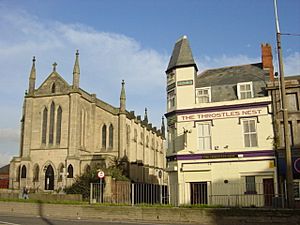Vauxhall, Liverpool facts for kids
Quick facts for kids Vauxhall |
|
|---|---|
 St Anthony's Church and The Throstles Nest public house, Scotland Road |
|
| Population | 6,699 (2001 Census) |
| OS grid reference | SJ345915 |
| Metropolitan borough | |
| Metropolitan county | |
| Region | |
| Country | England |
| Sovereign state | United Kingdom |
| Post town | LIVERPOOL |
| Postcode district | L3, L5 |
| Dialling code | 0151 |
| Police | Merseyside |
| Fire | Merseyside |
| Ambulance | North West |
| EU Parliament | North West England |
| UK Parliament |
|
Vauxhall is a part of Liverpool, England. It is located just north of the city centre. To its north is Kirkdale, and to its east is Everton. The River Mersey and the docks run along its western side.
Vauxhall is part of the Liverpool City Council area. In 2001, about 6,699 people lived there.
Contents
What is Vauxhall like?
Vauxhall is often called the "Scottie Road area." This is because a famous road, Scotland Road, runs right through it. The Scottie Press is a well-known local newspaper. It is known as "Britain's longest running community newspaper."
In 2008, Liverpool was the European Capital of Culture. To show Vauxhall's important part in the city's history, local people held their own celebration party. Sometimes, the media mistakenly calls Vauxhall by other names like Kirkdale or Everton.
The southern part of Vauxhall is close to the city centre. Here you can find Liverpool John Moores University at Byrom Street. This area has changed a lot over the years. There are also student homes nearby, like Atlantic Point.
Vauxhall's History
Scotland Road was built in the 1770s. It was a main road leading to Preston. It became part of a route for stagecoaches going to Scotland. That's how it got its name.
In the early 1800s, Liverpool grew bigger. Streets of homes were built along Scotland Road. Many of these older homes were later replaced with new buildings in the 1930s. In the mid-1800s, many Irish immigrants came to the area. They were looking for a better life, especially during the Great Famine. This made Scotland Road very crowded.
Eldon Grove was built in 1912. It offered better homes for workers. The Countess of Derby officially opened it.
In Victorian times, Vauxhall had over 200 public houses (pubs). Most of these are now gone. Vauxhall was part of old Liverpool before the city expanded.
Scotland Road was a busy place for working-class people in north Liverpool. Many different groups of people lived there. The largest group was Irish Catholic families. They arrived after the famine in 1847-1848. Vauxhall was close to both the city centre and the docks. It was a place where people shared a strong Liverpool-Irish identity.
In the 1960s and 1970s, many old buildings were taken down. The Wallasey Tunnel was also built. This caused many people to move to new homes in other parts of the city. These areas included Kirkby and Croxteth. This led to a decline in Scotland Road. More buildings were demolished in the 1980s and later.
New Homes in Vauxhall
In 2008, the Eldonian Village celebrated 30 years. This new housing estate was built on empty land in Vauxhall. Since then, more new homes have been built. These include Athol Village, next to the Leeds and Liverpool Canal. There are also new flats and student homes near Leeds Street. These new buildings are helping to improve the Vauxhall area. However, not much of the original Scotland Road remains.
In 2018, plans were announced to fix up the three blocks of Eldon Grove. They had been empty for over 16 years. The plans also include building a new block of flats nearby.
Famous Places in Vauxhall
Many of Vauxhall's old landmarks have been taken down or closed. But some important places still exist:
- St Anthony's Church
- St Sylvester's Church
- Stanley Dock
- Tobacco Warehouse
- Eldon Grove, located off Limekiln Lane.
- Throstles Nest (a pub next to St Anthony's Church)
The North Liverpool Community Justice Centre used to be in Boundary Street. It was in an old school building.
For the future, Peel Holdings has a big plan for the docks in Vauxhall. It is called Liverpool Waters. This project is expected to take many decades to finish.
Learning in Vauxhall
There used to be many schools in the "Scottie Road" area. But as fewer people live there, like pubs and churches, only a few schools remain:
- Holy Cross & St Mary's Catholic primary school
- The Trinity Catholic primary school
Well-known People from Vauxhall
Many famous people have come from Vauxhall. Some of them include:
- Cilla Black
- Tom Baker
- Bobby Campbell
- Laurie Carberry
- James William Carling
- Tommy Comerford
- Nancy Flanagan
- Thomas Cecil Gray
- Jackie Hamilton
- John Hines (Australian soldier)
- David Logan
- Jimmy Melia
- Johnny Morrissey
- James Nugent
- Robert Parry (MP)
- Father Tom Williams
See also
 In Spanish: Vauxhall (Liverpool) para niños
In Spanish: Vauxhall (Liverpool) para niños


